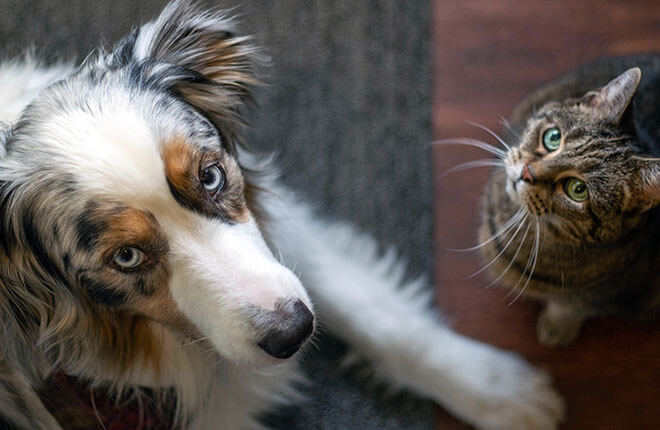Pets are family, and we want to help them with their physical and mental well-being. For our dogs and cats to thrive on all levels, we need to create the best environment for them. It's about looking at the world from their perspective and demystifying some of the "whys" behind their behavior. Only then can we give them what they need to feel confident, secure, and happy.
Pets and Their Behaviors
Your pet’s behavior can be influenced by genetics and what they learn from interacting with their environment. Their reaction (behavior) is based on what they need from, or how they feel about each situation that occurs in their lives. Your pet’s behaviors are a direct result of a combination of the situation that they are currently in and how they "feel inside". How they "feel inside" is influenced by their genetic makeup or predisposition and what they have learned from past experiences. Additionally, your pet may react differently in a specific situation or environment at different times because of how they are feeling at that time (happy or sad, anxious or fearful), which is a result of what they have learned and what they may or may not have experienced just beforehand. All of these factors can have a significant impact on their behavior. The most important thing to realize is that every behavior has a reason — even if it's not obvious to us humans.
Your dog might be barking at the mail carrier to make them go away or to protect their family (territorial behavior) out of fear. Or they may be barking out of excitement because they have positive feelings about the mail carrier (perhaps the mail carrier always gives your dog a dog treat). Being able to tell the difference between their fear or excitement will help you understand whether to allow your dog out to greet the mail carrier or distract them with something positive to do in another room.
Your cat may get agitated and run from window to window when they see another cat outside. On one hand, they might feel happy to meet their friend, but on the other hand, they could be feeling an urgent need to protect their resources and say, "Hey, this is my area." Again, being able to tell the difference between positive reactions and negative stress reactions will help you understand what your cat needs to feel secure and what you can safely allow them to do in a situation.
The most important way for us to be able to tell how our pet is feeling about a situation is by learning to read their body language. We need to invest in learning a foreign language and learn to interpret what their behavior is telling us about their feelings. Understanding some of the factors that influence your pet's behavior can help you see things from their perspective.

Instinctual Needs of Dogs and Cats
Our pets may be domesticated, but they still have instinctual needs and drives. Things like food, clean water, safety, and social structure are always top-of-mind with our pets. Looking at those needs can explain a lot about why they do what they do.
Cats, for example, don't scratch furniture, trees, and carpet just for claw care — it's a form of marking their territory. It can be a scent cue, pheromones (chemicals signals) from the paws tell other cats, "I was here yesterday." Or it can be a visual signal — the height and depth of the scratch marks tells other cats how big and formidable the cat who made the marks is. This is inherent — it's something they must do as an essential part of being a normal and healthy cat.
Dogs have instinctual drives to chase, dig, and chew. Punishment is unlikely to effectively stop these instinctual behaviors (unless so intense it becomes inhumane), but you can provide appropriate ways for them to fulfill these needs through enrichment activities.
Pet Emotions
Recent research has confirmed what many dog and cat owners have known for quite some time. Yes, our pets do feel emotion! Lucky for us, there isn't strong evidence to show that our pets are judging us, therefore is it unlikely that they feel jealousy or spite. But they have negative and positive emotional states and can feel things like happiness, love, anxiety, or fear that affect their mental state. And these emotions can affect their bodies in much the same way they affect ours. That's because emotions are directly linked to the stress systems in their bodies. If a cat or dog feels afraid, negative stress hormones increase in their body so they perform behaviors that instinctually would help keep them safe. If they feel happy, negative stress hormones decrease and there can be an elevation in other hormones associated with these positive emotions. And you guessed it, they then perform behaviors that demonstrate those positive emotions! The question is, how can we know what they're feeling and use it to improve their lives? We can't just ask them. But we can look at their behavior and motivations.
The Power of Positive and Negative Associations
Our pets are constantly categorizing the world into two buckets, which determines how they feel about different things and, in turn, how they react. Though this is a simplistic view, it is a fair way to consider how your pet feels about the situations around them.
- Safe or unsafe. The first category to assess is: Do they feel safe or unsafe? If something is deemed unsafe, they seek to avoid, prevent, or actively defend themselves against it. Things your pet sees as unsafe will trigger the instinctual fight or flight response.
- Good, bad, or indifferent. The second category is whether they anticipate a positive, negative, or neutral response or consequence to the situation. Does its presence usually mean something good is going to happen? Suppose your mail carrier tosses a treat to your dog or pets the cat every time they deliver your mail. In that case, your pets will have a positive association — the mail carrier equals yummy food and scratches. This means that your pet will be more likely to perform behaviors that help him get to the mail carrier to say hello so he can get his treat or pets. However, if every time your mail is delivered your pet experiences something startling, unfamiliar, or scary, like the mail truck door being slammed loudly, then they will have a negative association — mail carrier equals a scary sound. This means that your pet will likely perform a behavior to help him avoid the mail carrier and consequently hearing that scary sound. Situations that your pet interprets as meaningless, or indifferent, will result in less and less behavior being performed each time it occurs. There’s no point in wasting energy running toward or away from the mail carrier if nothing (good or bad) ever happens when they arrive.
- Law of Effect. The most important part about this concept (called the “Law of Effect”) is that it’s your pet that gets to decide whether the consequence is good, bad, or indifferent, not us. No matter how we hope they see it, it and how they consequently respond, it’s ultimately up to them
Dogs and Cats Are Not People
It can be tempting to assume our pets feel a certain way because that's how we would feel. For example, "My cat is mad at me for getting a new kitten, so he's not using his litter box." "My dog is acting guilty, so she must have gotten into the garbage while I was out. She knows better." This is called anthropomorphizing and can cause a lot of miscommunication and frustration when trying to help our pets.
In these scenarios we're projecting those human morals and ideals, leading you to negative feelings toward your pet. In reality, cats aren't capable of spite and, therefore, cannot be spitefully going outside the litter box to express anger at you. They're trying to tell you something is wrong. But another beautiful thing about your pet is that they are very much in the moment. Dogs aren't making a connection between something they did three hours earlier and what you're seeing when you come home — they're reacting to your current state of anger, but don't have a clue that it’s because there is garbage strewn all over the floor. At worst, they associated it with something occurring at that moment — you coming home, a bunch of grocery bags in your arms, you loudly screaming "What did you do now?", definitely not with getting in the trash three hours ago. That look of guilt is an appeasement gesture from your dog, trying to tell you they're no threat and please calm down.
What Can We Do to Support Our Pets?
There may be more to truly understanding your cat or dog than you thought. But what an excellent opportunity to strengthen your bond and give them an even better life than you'd imagined. Just remember:
- Don't project human reasons or reactions onto your pet. Look at things from their perspective, not yours.
- Learn how to interpret their body language so you can figure out how they're feeling about a situation.
- Use positive reinforcement-based training to show them how you would like them to respond to different situations.
- Give them appropriate enrichment opportunities for behaviors they instinctually need to do.
- Create positive associations with potentially scary or intimidating things or situations.
- Consider working with a qualified humane force-free training or behavior professional if your pet seems to be struggling with behavioral issues, fear, or anxiety.
ZPC-01223R1

.jpg)

